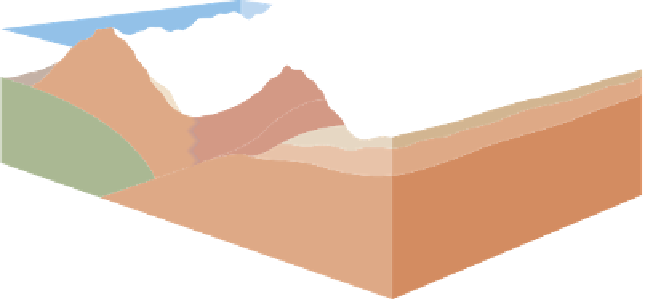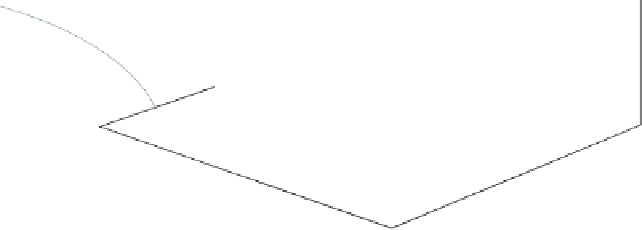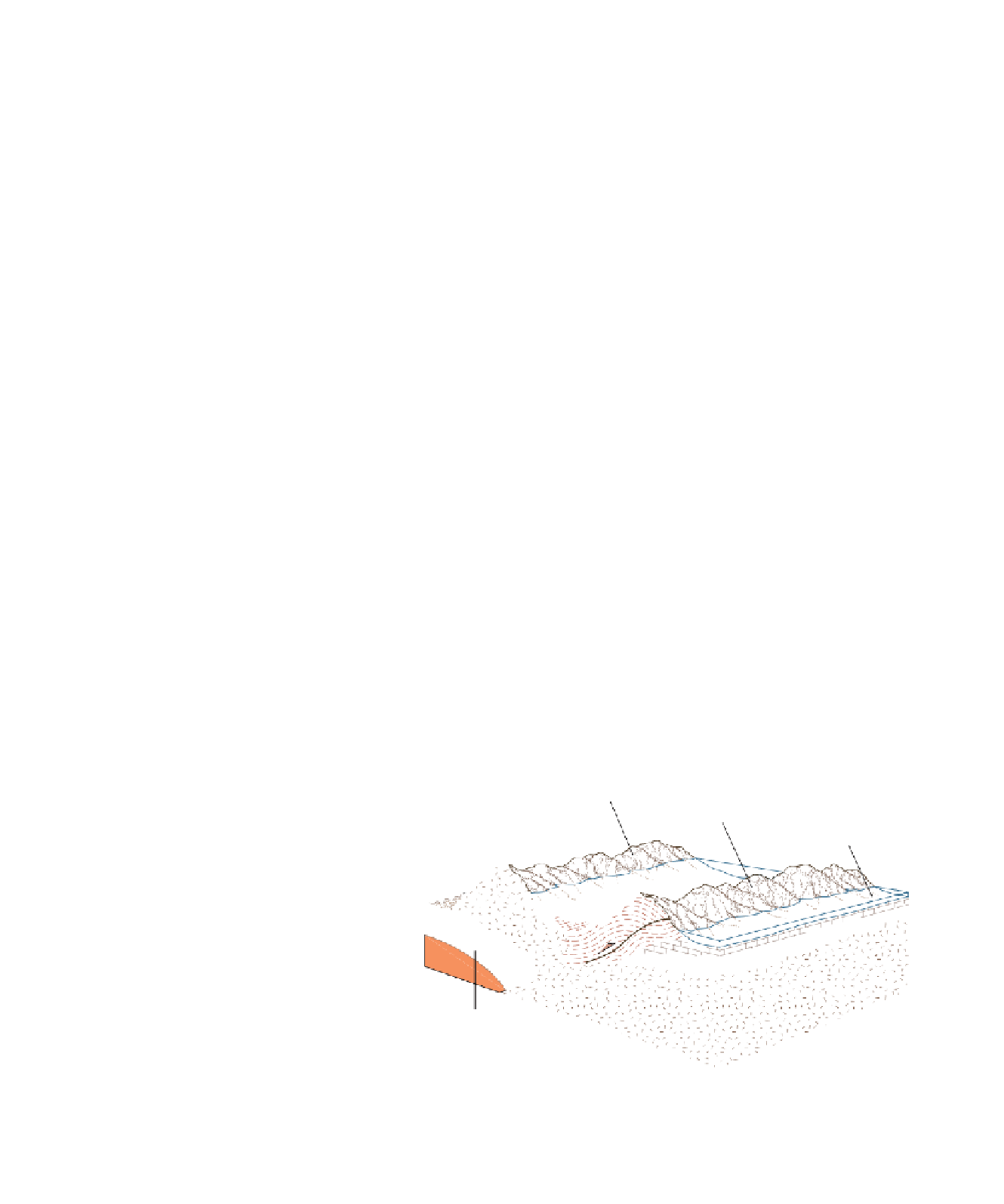Geology Reference
In-Depth Information
continental shelf sediments were deposited. Thick sections of
marine sediments graded laterally into thin cratonic units as the
Sauk Sea transgressed onto the craton. Beginning in the Middle
Paleozoic, an island arc formed off the western margin of the
craton. A collision between this eastward-moving island arc
and the western border of the craton took place during the Late
Devonian and Early Mississippian, producing a highland area.
This orogenic event, the
Antler orogeny
, was caused by
subduction, resulting in deep-water deposits and oceanic
crustal rocks being thrust eastward over shallow-water con-
tinental shelf sediments, thus closing the narrow ocean basin
separating the island arc from the craton (
the Ouachita mobile belt was very complex and involved not
only the collision of Laurasia and Gondwana, but also several
microplates and terranes between the continents that eventu-
ally became part of Central America. The compressive forces
impinging on the Ouachita mobile belt also affected the craton
by broadly uplifting the southwestern part of North America.
TERRANES PLAY IN THE FORMATION
OF PANGAEA?
We have presented the geologic history of the mobile belts
bordering the Paleozoic continents in terms of subduction
along convergent plate boundaries. It is becoming increas-
ingly clear, however, that accretion along the continental
margins is more complicated than the somewhat simple,
large-scale plate interactions that we have described. Geolo-
gists now recognize that numerous terranes or microplates
existed during the Paleozoic and were involved in the oro-
genic events that occurred during that time.
In this chapter, we have been concerned with only the six
major Paleozoic continents. However, terranes and micro-
plates of varying sizes were present during the Paleozoic
and participated in the formation of Pangaea. For example,
as we mentioned earlier in this chapter, the microcontinent
of Avalonia consists of some coastal parts of New England,
southern New Brunswick, much of Nova Scotia, the Avalon
Peninsula of eastern Newfoundland, southeastern Ireland,
Wales, England, and parts of Belgium and northern France.
This microcontinent separated from Gondwana in the Early
Ordovician and existed as a separate continent until it col-
lided with Baltica during the Late Ordovician-Early Silurian
and then with Laurentia (as part of Baltica) during the Silu-
rian (Figures 20.2b, c and 20.3a).
Other terranes and microplates include
Iberia-Armorica
(a portion of southern France, Sardinia, and most of the
Iberian peninsula),
Perunica
(Bohemia), numerous Alpine
◗
Figure 20.27).
Erosion of the resulting Antler Highlands produced large
quantities of sediments that were deposited to the east in
the epeiric sea covering the craton and to the west in the
deep sea. The Antler orogeny was the fi rst in a series of oro-
genic events to affect the Cordilleran mobile belt. During
the Mesozoic and Cenozoic, this area was the site of major
tectonic activity caused by oceanic-continental convergence
and accretion of various terranes.
The Ouachita mobile belt extends for approximately
2100 km from the subsurface of Mississippi to the Marathon
region of Texas. Approximately 80% of the former mobile
belt is buried beneath a Mesozoic and Cenozoic sedimen-
tary cover. The two major exposed areas in this region are
the Ouachita Mountains of Oklahoma and Arkansas and the
Marathon Mountains of Texas.
During the Late Proterozoic to Early Mississippian,
shallow-water detrital and carbonate sediments were depos-
ited on a broad continental shelf, and in the deeper-water
portion of the adjoining mobile belt, bedded cherts and
shales were accumulating (
◗
Figure 20.28a). Beginning in
the Mississippian Period, the rate of sedimentation increased
dramatically as the region changed from a passive continen-
tal margin to an active convergent plate boundary, mark-
ing the beginning of the
Ouachita orogeny
(Figure 20.28b).
Thrusting of sediments continued
throughout the Pennsylvanian and Early
Permian, driven by the compressive forces gen-
erated along the zone of subduction as Gond-
wana collided with Laurasia (Figure 20.28c).
The collision of Gondwana and Laurasia is
marked by the formation of a large mountain
range, most of which eroded during the Meso-
zoic Era. Only the rejuvenated Ouachita and
Marathon Mountains remain of this once-
lofty mountain range.
The Ouachita deformation was part
of the general worldwide tectonic activity
that occurred when Gondwana united with
Laurasia. The Hercynian, Appalachian, and
Ouachita mobile belts were continuous and
marked the southern boundary of Laurasia
(Figure 20.4). The tectonic activity that uplifted
Volcanic arc
Antler Highlands
Continental shelf
Oceanic crust
Continental crust
◗
Figure 20.27
Antler Orogeny Reconstruction of the Cordilleran mobile belt
during the Early Mississippian in which deep-water continental slope deposits were
thrust eastward over shallow-water continental shelf carbonates, forming the Antler
Highlands.













Search WWH ::

Custom Search